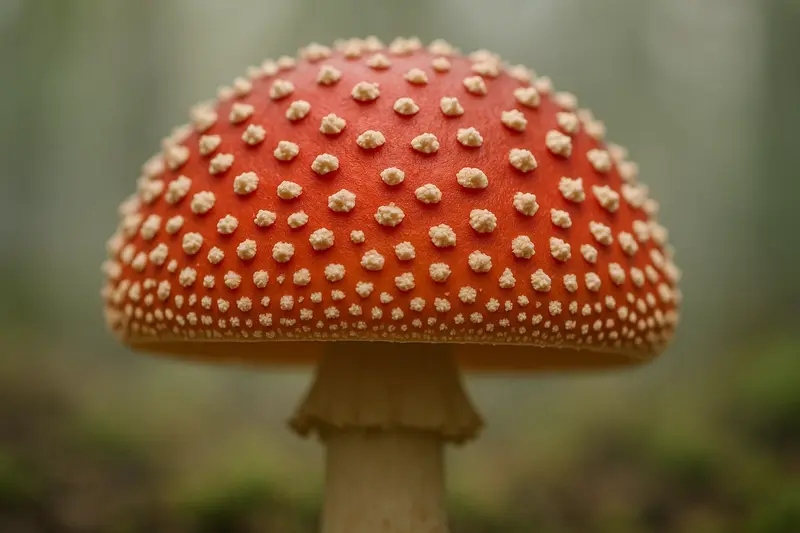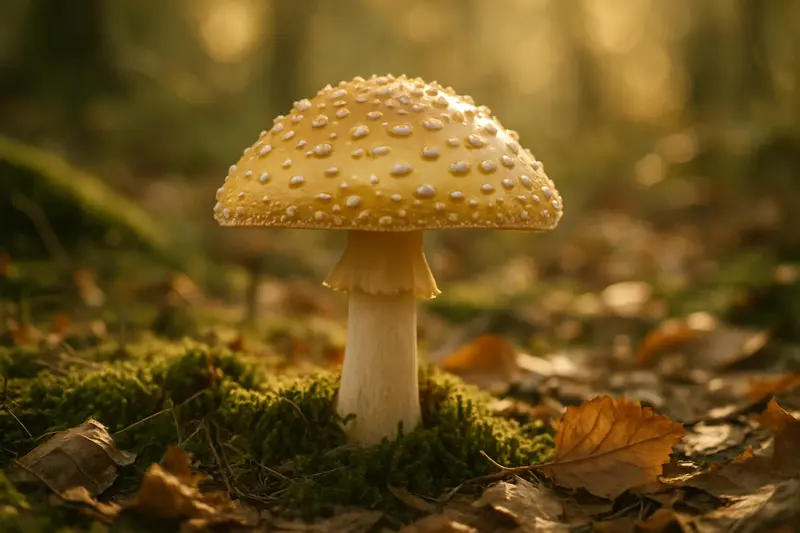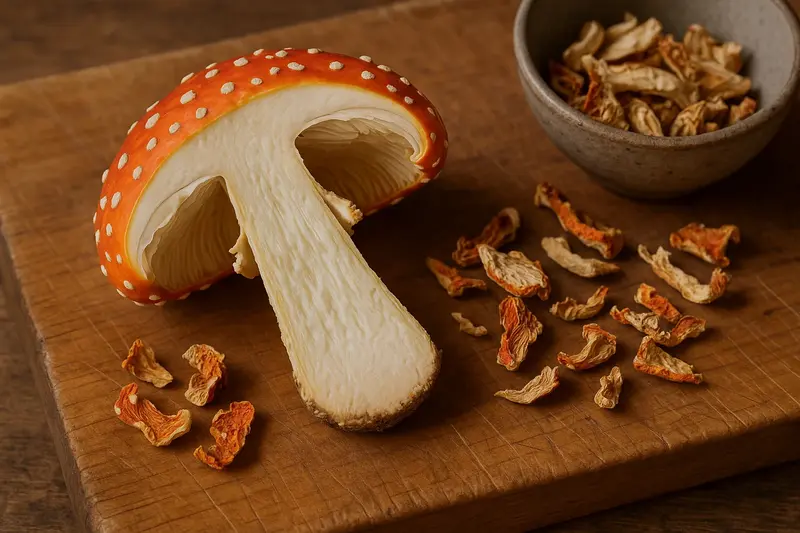
Amanita muscaria – the iconic red mushroom with white spots – is often what comes to mind when imagining a fairy-tale toadstool. Unlike typical “magic mushrooms” that contain psilocybin, this mushroom’s magic comes from a different source. Amanita muscaria is psychoactive yet legal in most places, making it a curiosity for those seeking a mind-altering experience without breaking the law. In this post, we delve into what makes A. muscaria unique, how it differs from psilocybin-containing mushrooms in chemistry and effects, and explore its potential benefits and serious risks. Not all “magic mushrooms” are alike – and understanding Amanita’s distinct nature will help you approach it with eyes wide open.
Often called the “fly agaric,” Amanita muscaria is widely recognized from folk tales and even video games for its bright scarlet cap dotted with white warts. Historically, it earned the nickname fly agaric because pieces of the mushroom were used to attract and stupefy flies when placed in milk. Beneath its whimsical appearance, however, lies a potent cocktail of compounds. Fresh A. muscaria is considered poisonous if eaten raw, but it has been consumed in certain cultures after careful preparation to remove toxins. For example, traditional recipes involve boiling the mushroom and discarding the water (which carries away water-soluble toxins), or long brine-soaking methods in Japan, to make it safe to eat. These practices highlight an important point: raw Amanita muscaria is not a harmless snack. Yet, this mushroom has a storied history of human use. From Siberian shamans who consumed it in spiritual ceremonies thousands of years ago, to its depictions in Alice in Wonderland and Super Mario, A. muscaria has captured human imagination.
The key distinction between Amanita muscaria and true “magic mushrooms” boils down to chemistry. Psilocybin mushrooms (such as Psilocybe cubensis and many others) contain psilocybin and psilocin, which interact with serotonin receptors in the brain to produce classical psychedelic effects. Amanita muscaria, on the other hand, contains muscimol and ibotenic acid as its primary actives – entirely different compounds. Muscimol is a 3D analog of GABA (gamma-aminobutyric acid), meaning it binds to GABA<sub>A</sub> receptors as a potent central nervous system depressant. In plain terms, muscimol calms or sedates the brain rather than stimulating it. Psilocybin, by contrast, primarily agonizes the 5-HT<sub>2A</sub> serotonin receptors, leading to sensory enhancements, euphoria and profound changes in perception and cognition.
What does this mean for the user? Muscimol’s effects are very different from psilocybin’s. Amanita muscaria is often classified as a deliriant or dissociative hallucinogen rather than a classic psychedelic. It doesn’t engender the clear-headed, insightful “trip” associated with psilocybin. Instead, muscimol tends to induce an ethereal, dreamlike and sedative state. Users may feel drowsy, inebriated, or as if they are in a lucid dream. Visions can occur, but often with a confused, delirious quality rather than the vivid, structured visuals of a psilocybin experience. As one scientific article succinctly puts it: A. muscaria “doesn’t act on the same receptors as psilocybin… Instead [it acts] on receptors that can cause an ethereal, dreamlike and sedative state”. Psilocybin mushrooms, in contrast, tend to heighten sensory perception, produce euphoria and introspection, and even facilitate spiritual or “mystical” experiences under the right conditions.
Another major difference is in onset and bodily effects. Amanita muscaria’s ibotenic acid is partially converted to muscimol in the body after ingestion. This can lead to an unpredictable alternation between stimulation and sedation as the two compounds exert opposite effects. Reports often include an initial phase of confusion, dizziness, agitation, ataxia (loss of coordination) and perceptual distortion, followed by heavy sedation or sleep with vivid dreams. In contrast, psilocybin typically has a more uniform trajectory – coming up in 30-60 minutes, peaking with visual and emotional effects, and then tapering over a few hours in a gentler “afterglow.” The Amanita experience, especially at higher doses, can be comparably murky or disorienting. It’s not unusual for Amanita users to essentially black out or fall into a deep sleep and later recall dreamlike hallucinations, whereas psilocybin users usually remain awake and cognizant (if altered) during their trip.
One reason Amanita muscaria is garnering attention is its legal status. In the United States and many other countries, psilocybin mushrooms are classified as controlled substances (Schedule I in the U.S.), making them illegal to grow, possess, or sell (outside of approved research). Amanita muscaria, however, is not a controlled substance under U.S. federal law. The psychoactive compounds muscimol and ibotenic acid do not appear on the DEA’s scheduling list at all, which makes Amanita muscaria federally legal in the U.S.. In fact, as of this writing, 49 out of 50 U.S. states allow Amanita muscaria to be bought and sold; the sole exception is Louisiana, which passed a special law banning A. muscaria along with several other hallucinogenic plants/fungi (except for ornamental use). Notably, the FDA has never approved Amanita muscaria for human consumption as food or medicine, but that hasn’t stopped entrepreneurs from taking advantage of its legal gray zone.
Because it’s largely unregulated, Amanita products have exploded onto the market in recent years. It’s easy to find Amanita muscaria being sold online in the form of dried caps, tinctures, and even “magic mushroom” gummies and chocolates that boast legal status. These products are often marketed with suggestive health claims – for example, promoting relaxation, anxiety relief or lucid dreaming. The irony is that many vendors piggyback on the hype of psilocybin research to sell Amanita, even though the two are not the same. A 2024 study observed that interest in Amanita muscaria surged partly because of “emerging clinical research supporting the safety and efficacy of psilocybin as a treatment for depression” – interest that savvy marketers have leveraged. Some brands deliberately label their Amanita-infused edibles as “magic mushroom” treats without clearly distinguishing the species, potentially confusing consumers. Experts warn that this is misleading and risky, since muscimol has essentially no clinical research in humans yet to support therapeutic use.
The “buyer beware” nature of the Amanita market is emphasized by public health officials. Because Amanita muscaria is not scheduled, it isn’t subject to the same strict regulations, testing, or age restrictions that govern legal cannabis or experimental psilocybin programs. “Companies…are getting away with making a buck until someone tells them they can’t,” one public health researcher noted, calling it a Wild West situation. In one review, scientists pointed out that Amanita muscaria sales are often completely unregulated by law – the mushroom is easily available online, whereas psilocybin mushrooms remain illegal despite being arguably less acutely toxic. For the consumer, this means the onus is on you to ensure safety and quality if you decide to experiment with Amanita products.

Despite the cautions, it’s worth exploring why people are interested in Amanita muscaria and what potential benefits it might offer. Historically, Amanita muscaria holds a significant place in shamanic and folk medicine traditions. In Siberia, it was used by shamans to induce trance states and communicate with the spirit world. There are even reports of it being used as an intoxicant in place of alcohol in certain indigenous groups. This traditional usage hints at effects like euphoria, pain relief, and altered consciousness that were harnessed in cultural contexts.
In modern times, some users experiment with Amanita muscaria in small doses (microdoses) to help with anxiety, insomnia, or general well-being. Muscimol’s action on GABA receptors implies a sedative, anxiolytic (anti-anxiety) effect somewhat akin to a benzodiazepine or a sleeping aid, though via a different pathway. Early research and anecdotal evidence suggest there may indeed be therapeutic potential. For instance, one Canadian company has developed a purified muscimol extract from Amanita (commercially known as AME-1) and reports that it “has been shown to treat stress and anxiety, ease muscular pain and promote restorative sleep.” These claims, while needing rigorous clinical verification, align with why many people are drawn to Amanita – they seek relaxation, relief from tension, and better sleep, all within a legal framework.
Additionally, a 2025 scientific review on Amanita muscaria noted that researchers are now considering its possible uses for a range of conditions. Preclinical and historical data hint that A. muscaria could be “potentially useful in the fight against depression, anxiety disorders, sleep disorders, autism spectrum disorders, and even addictions,” according to the latest research. It’s important to stress that this is potential, not proven treatment – the review also emphasizes that current studies are insufficient and we don’t yet fully understand how Amanita compounds affect the human body. Nonetheless, it shows that reputable scientists are at least asking the question of whether muscimol (or other compounds in Amanita muscaria) might be harnessed for good.
Even in smaller, personal-scale studies, there are intriguing observations. One case report of an individual microdosing Amanita over several months recorded improvements in mood and sleep, though such self-reports are hardly definitive. At the very least, muscimol’s known pharmacology as a GABAergic agent supports the idea that in carefully measured doses, it could act as a mild relaxant or sleep aid. In fact, some users liken a light Amanita dose to a dreamy sedative experience with less impairment than alcohol – although experiences vary widely.
It’s also possible that Amanita muscaria contains other medicinally interesting compounds. For example, the mushroom is high in antioxidants like tocopherols (vitamin E) and has been studied for neuroprotective effects in cell models. These are peripheral benefits that might come from certain preparations or extracts, though not the main reason people seek it out.
Bottom line: There are glimmers of potential benefits to Amanita muscaria – especially for relaxation, sleep, and perhaps anxiety relief – but these must be weighed against the risks and the scant state of clinical research. Unlike psilocybin (which is now in advanced trials for depression and other conditions), muscimol’s therapeutic use is still in its infancy. If you’re considering Amanita for any sort of self-treatment, know that you’re essentially going off of tradition and theory, not solid science. Always approach with caution and informed respect.

While Amanita muscaria is legal, that does NOT mean it is safe. This mushroom is, in fact, classified as poisonous. Muscimol and ibotenic acid are potent neurotoxins in high doses, capable of causing serious harm. Medical literature contains cases of Amanita muscaria poisoning where people accidentally or intentionally consumed too much and experienced vomiting, delirium, seizures, coma, and in rare instances even death. A review of toxicology reports confirms that common symptoms of Amanita intoxication include confusion, agitation, dizziness, loss of coordination, and perceptual disturbances; in severe poisoning, coma or respiratory failure can occur. Indeed, fatal poisonings have been recorded – for example, an Italian diplomat famously died in 1897 after consuming a large Amanita muscaria meal. Modern hospital case reports continue to warn that Amanita muscaria ingestion can lead to life-threatening situations requiring intensive care support.
Why such danger? Part of the risk comes from ibotenic acid, which is not only psychoactive but also excitotoxic (overstimulating neurons). If Amanita muscaria is not prepared properly – specifically, if ibotenic acid isn’t mostly converted to muscimol – the consumer is in for a very rough ride. In the words of one expert, improper processing can lead to “a nasty experience including sweating, nausea, loss of balance and involuntary bodily movements”. These are classic signs of cholinergic poisoning and neurological distress. Proper drying (usually at low heat) can decarboxylate much of the ibotenic acid to muscimol, reducing toxicity. Traditional methods like boiling and discarding the water also help leach out toxins. Never consume Amanita muscaria fresh – that is a recipe for unpredictable toxicity. Even dried, one should dose very carefully, as potency can vary from mushroom to mushroom.
Another risk factor is misidentification. Fortunately, Amanita muscaria’s unique appearance makes it unlikely to be confused with most edible mushrooms (its red cap with white speckles is a dead giveaway). However, once the white flakes wash off (as in heavy rain or cleaning), a red Amanita cap could be mistaken for something like Amanita caesarea (an edible species). There are also related species, like Amanita pantherina (the panther cap), which contain the same toxins in different proportions. In fact, Amanita pantherina has even more muscimol relative to ibotenic acid and is considered even more sedative; both are dangerous if misused. For foragers and experimenters: extreme caution is advised. Make sure you know exactly what mushroom you have, and when in doubt, do not ingest it.
Dose control with Amanita products is also tricky. Unlike standardized psilocybin doses (e.g., a microdose capsule containing a known quantity of psilocybin), Amanita gummies or tinctures may not always list an exact muscimol content – and even if they do, the industry lacks oversight. The result is a risk of accidentally taking more than intended. Always start with an exceptionally small amount if you are new to Amanita, and wait several hours before considering more. Remember, effects can take 30 minutes to 2 hours to kick in fully, and they might come in waves (excitation then sedation). It’s easy to underestimate Amanita muscaria because it’s legal and sold openly, but its compounds can be extremely potent. One analysis even suggested muscimol’s toxicity (in animal models) can surpass that of substances like fentanyl or PCP on a milligram-to-milligram basis. While that comparison is context-dependent, it underscores that the margin between an intoxicating dose and a harmful dose is narrow for muscimol.
Finally, there’s the general risk of unpredictable psychological reactions. Muscimol’s hallucinogenic effects can include delirium, panic, or disturbing visions, especially if you accidentally take too much. Unlike the often expansive or euphoric mindset of a psilocybin trip, a muscimol experience might leave one disoriented and anxious if things go wrong. Combining Amanita muscaria with other substances (like alcohol or sedatives) is particularly dangerous, as it could amplify central nervous system depression.
In summary, if you choose to explore Amanita muscaria, do so with great respect and caution. Treat it as you would any powerful, wild substance. Research safe preparation techniques, stick to low doses, have a sober sitter if possible, and be near a comfortable spot to lie down (since sedation is likely). Because Amanita is unregulated, you are effectively conducting an experiment on yourself – one that should be taken seriously. When in doubt, consult reliable guides or communities for harm reduction advice rather than diving in recklessly.
To wrap up, let’s highlight the key differences between Amanita muscaria and psilocybin mushrooms in a concise way:
Amanita muscaria stands out as a legal “magic mushroom” that offers a very different journey than its psilocybin-packed cousins. For the curious psychonaut, it can provide a glimpse into altered consciousness – one that is deeply sedative, dissociative, and steeped in ancient lore. Its legality in most regions certainly lowers the barrier to access; one can buy Amanita mushroom gummies or powders online and partake without fear of legal repercussions. This makes A. muscaria alluring to people who cannot obtain illicit psychedelics but still want to explore non-ordinary mental states. Additionally, the mushroom’s potential benefits for anxiety or sleep (if properly harnessed) add to its appeal as a sort of folk-medicine ally.
However, being legal doesn’t mean Amanita muscaria is universally safe or advisable. We’ve seen that it carries genuine risks of poisoning and unpredictable effects. The entirely different chemistry of muscimol means the experience can be as disorienting as it is illuminating. Consumers should be extremely mindful of sourcing (know that what you’re buying is indeed Amanita and is prepared correctly), dosing, and setting. If your goal is casual recreation, Amanita’s effects might actually be too incapacitating and not all that “fun” – it’s not a party drug by any stretch. If your goal is self-medication (say, for anxiety or insomnia), be aware that evidence is still preliminary, and there might be safer, better-studied options available.
For those intrigued by mushrooms for mood enhancement or personal growth, it’s worth comparing Amanita with other options. Psilocybin microdoses, for example, have gained popularity for subtly boosting mood, creativity, and emotional balance. These are illegal in many areas (including federally in the U.S.), yet they are backed by more scientific research and a growing community of practice. If you’re in a jurisdiction where psilocybin is decriminalized or accessible, you might find that microdosing psilocybin is a more predictable and therapeutically grounded path than experimenting with Amanita. Good Moods, for instance, offers a variety of psilocybin microdose products – from capsules to edibles – that are formulated for consistency and safety. These controlled microdoses (e.g. our daily mushroom supplement or microdose gummies) deliver a gentle lift in mood and focus, with research-backed ingredients, as opposed to the sedative delirium of a muscimol experience. While we currently don’t carry Amanita-based products, we encourage consumers to explore our curated selection of psilocybin microdose supplements as a more evidence-based alternative for wellness.In the end, Amanita muscaria occupies a unique niche in the psychoactive world. It’s a legal entheogen with a legendary past and a cautious present. If you choose to walk this mushroom’s path, do so with respect: respect for the traditional knowledge behind its use, respect for the powerful neurochemical effects it unleashes, and respect for your own health and safety. Stay informed, start low, and always prioritize your well-being over the lure of the “legal high.” Not all mushrooms are created equal, and Amanita muscaria – the red fairy mushroom – is truly its own kind of magic, best approached with care and wisdom.
About Good Moods
Good Moods Inc. | 70 SW Century Dr Bend, Oregon 97702 Sitemap Blogs
You must be 21 years of age or older to make a purchase from this website. All Good Moods plant medicine products are for healing purposes only.